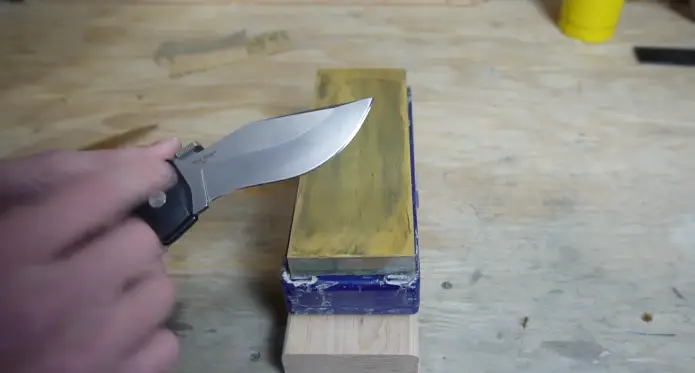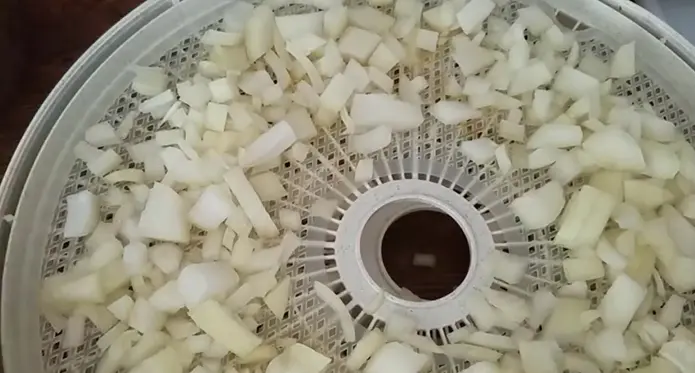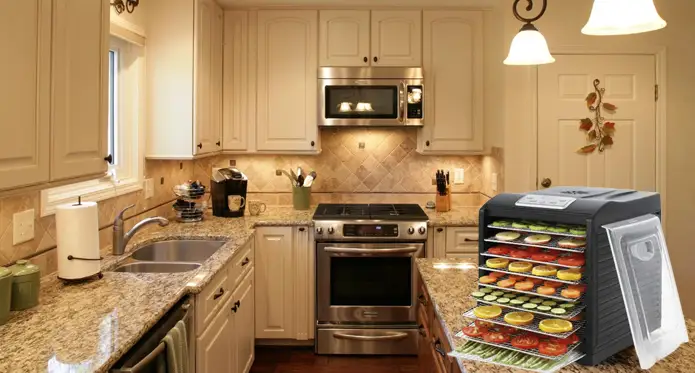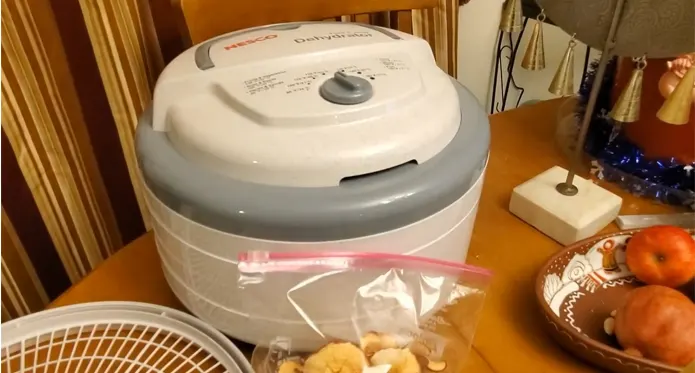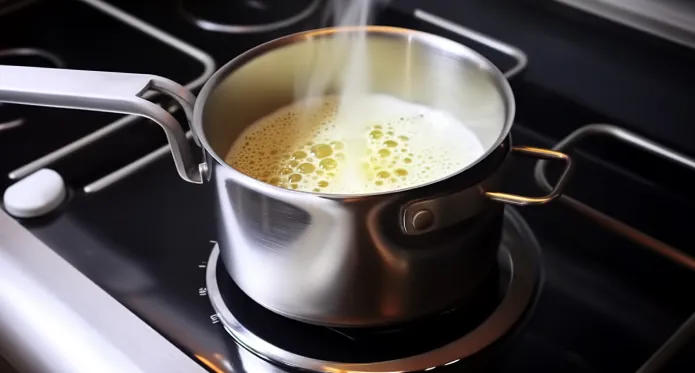How to Sharpen A Curved Knife | 6 Steps [DIY]
Curved knives, such as hawkbill, kukri, and karambit, possess unique sharpening challenges. Unlike straight blades, these knives require special attention to maintain their curved edge. So, how do you ensure your curved knife is as sharp as possible? Well, it’s not as straightforward as sharpening a straight blade.
To sharpen your curved knife, understand your knife’s specific design and features. Choose the right tools and materials, such as a round-edged stone and a stropping tool.
Also, use a round-edged stone with light force and smooth strokes to maintain a consistent angle, and take your time for precision and attention to detail.
In this comprehensive DIY guide, I’ll explain the six steps to sharpening a curved knife effectively. So keep reading to maintain the proper sharpness for your curved knife.
How to Sharpen a Curved Knife: Six DIY Steps to Follow
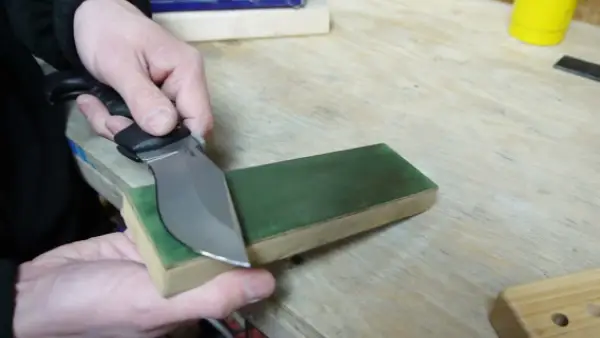
To sharpen a curved knife, carefully follow the steps I’ve listed below:
- Gather the right tools and materials
- Understand the knife features
- Follow proper sharpening techniques
- Specific knife sharpening examples
- Alternative systems and height adjustment
- Stropping and final checks
Step 1: Gather the Right Tools and Materials
Ensure you have the necessary tools and materials before diving into the sharpening process for your curved knife. You’ll need:
- A round-edged stone to ensure proper contact with the curved blade
- A stropping tool and a soft leather strap for refining the blade’s edge
- Stone maintenance tools for chipped edges
Having these tools and materials ready will ensure you can efficiently and effectively sharpen your curved knife.
Step 2: Understand the Knife Features
Before proceeding with the sharpening process for your curved knife, take the time to understand the specific design and features.
Different curved knives may have varying degrees of curvature and specific features. For instance, a round-edged stone benefits gentle inward curves near the heel. Familiarizing yourself with the specific design of your knife is crucial before you start sharpening.
Step 3: Follow Proper Sharpening Techniques
Consider using a round-edged stone and employing light force and smooth strokes on both sides when sharpening a curved knife. The key is to maintain a consistent angle, typically around 25 degrees, and move the blade along the stone sweepingly. This helps to ensure that both sides of the curved edge are sharpened evenly.
When dealing with serrated edges, angle the knife to match the bevel of the serrations and use short, light strokes with a slight twisting motion to maintain the serrations’ shape. Remember to take your time and be patient, as sharpening a curved knife requires precision and attention to detail.
Step 4: Specific Knife Sharpening Examples
To achieve a razor-sharp edge on your curved knife, understand the specific sharpening techniques for different curved knives. Use a smooth, gentle stroke along the serrations for serrated edge knives to maintain their shape.
When sharpening concave-edged knives like linoleum knives, focus on maintaining the bevel using light strokes on both sides. Grafting knives, used for delicate horticultural work, require careful sharpening to ensure precision cuts.
Understanding the nuances of sharpening each type of curved knife is crucial to preserving its unique characteristics and functionality.
Step 5: Alternative Systems and Height Adjustment
You may enhance your sharpening process by utilizing alternative systems such as Lansky Turn Box or Spyderco Sharp Maker for recurve blades. These systems are designed to accommodate the unique shape of curved knives, allowing for more precise sharpening.
When using a flat stone, I suggest elevating the blade to avoid interference with the countertop or work surface. This ensures that you can maneuver the blade without any hindrance. Additionally, pay close attention to wear and tear, especially when sharpening recurves with the corner of a stone.
Step 6: Stropping and Final Checks
Once you have finished sharpening the curved knife, the next step is to strop the blade carefully using a soft leather strap. Apply light pressure to the blade while stropping to avoid rounding off its edge. Move the knife away from the cutting edge when stropping to prevent accidental cuts.
After stropping, conduct a paper test to check the sharpness of the entire blade, including the recurve area. Ensure the blade easily slices through the paper with clean, smooth cuts. If the blade doesn’t meet the desired sharpness level, repeat the stropping process until the entire blade is uniformly sharp.
Can I sharpen a curved knife with sandpaper?
When sharpening a curved knife with sandpaper, raise the handle slightly while sliding the edge across the sandpaper to sharpen the entire length of the blade.
This technique is particularly important for curved knives, as it allows you to maintain the consistent curve of the blade while sharpening. Raising the handle slightly ensures that the entire edge comes into contact with the sandpaper, resulting in a uniform and effective sharpening process.
Using sandpaper to sharpen a curved knife can be practical and cost-effective, especially if you don’t have specialized sharpening tools. It allows you to control the sharpening process and adjust the pressure and angle to achieve the desired sharpness.
Why do curved knives require a different sharpening approach than straight knives?
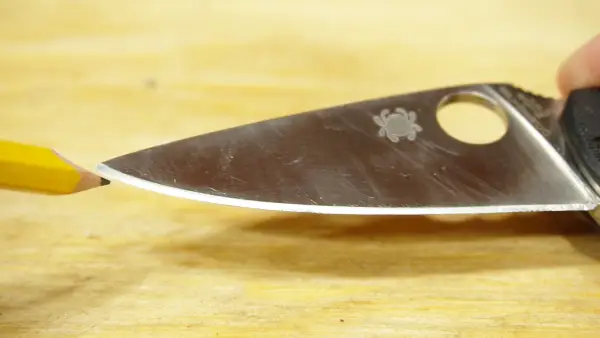
Understand why curved knives need a different technique than straight knives when sharpening them with sandpaper. The unique shape of curved knives, such as hawkbill or karambit, demands special attention during sharpening.
Unlike straight blades, the curvature of these knives requires a round-edged stone for proper contact and effective sharpening. The curve of the blade means that a traditional flat sharpening stone may not make sufficient contact with the entire edge, potentially leaving parts of the blade dull.
Additionally, the curved shape presents a challenge when using traditional sharpening techniques, as the angle and pressure must be consistently maintained along the entire curve length. Therefore, a different approach is necessary to ensure that the entire edge of a curved knife is sharpened uniformly and effectively.
Can I use a flat stone to sharpen a curved knife?
Using a flat stone to sharpen a curved knife isn’t recommended for recurve blades due to the potential premature wear on the stone. The curved shape of the blade makes it challenging to maintain consistent contact with a flat stone, leading to uneven sharpening and premature wear on the stone.
Instead, I advise using a round-edged stone that matches the curvature of the blade. This ensures the cutting edge contacts the sharpening surface, resulting in a more uniform and effective sharpening process that prevents knife edge breakage.
How do I choose the right angle for sharpening a curved knife?
To achieve optimal sharpness for a curved knife, carefully select the angle at which you position the blade against the sharpening stone.
When sharpening a Wusthof curved knife, I recommend maintaining a consistent angle throughout the process. The recommended angle for sharpening a curved knife is typically between 10 to 20 degrees. This range allows for a balance between achieving a sharp edge and preserving the blade’s integrity.
To determine the right angle, consider the curvature of the blade. Start by identifying the knife’s bevel, then position it on the sharpening stone. Maintaining a steady hand and applying even pressure is vital to ensure that the entire edge of the curved blade is sharpened uniformly.
Sharpen Curved Knives Like a Pro With Easy Steps
Mastering the sharpening of curved knives is a valuable skill for any knife enthusiast. Now that you’ve learned the six DIY steps for sharpening a curved knife, you can confidently tackle this task at home.
Always remember using sandpaper to sharpen a curved knife is okay, and a flat stone may not be the best option. When choosing the right angle for sharpening, trust your instincts, and practice makes perfect.
With these steps I’ve discussed, you’ll be sharpening curved knives like a pro in no time, making it seem as easy as slicing through butter.

